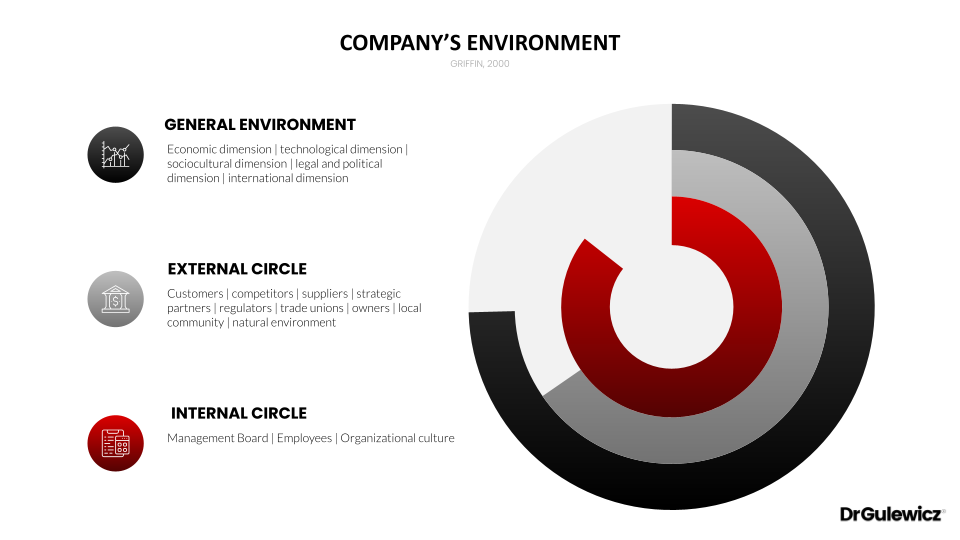If there is one success factor that is most often forgotten or not properly taken into account in the company’s business strategy, it is the company’s environment.
The environment plays a very important role in the success or failure of your business.
No organization functions in isolation from the environment, so you must make efforts to understand its basic elements.
What Is The Company’s Environment?
First, it is the general environment of your company (political, economic, socio-cultural, etc.), then the external circle (customers, competitors, partners, suppliers, local community, etc.), and the internal circle, i.e. the management board, employees, and culture.

As a leader, you must have a deep understanding and the ability to assess the environment in which you and your company operate.
Therefore, you need to perform a deep-dive analysis of the environment of your company and assess how it impacts your business development strategy.
In this article, I will walk you through step-by-step describing each element of those assessments.
Assess The Company’s General Environment
Take a time to reflect on the general environment of your business.
First, assess the overall health of the ECONOMIC system in which your company operates. Particularly important economic factors are inflation, interest rates, unemployment, and demand. Sometimes a generally bad market situation supports certain business sectors. So you need to identify how this specific economic situation is affecting YOUR business. How do YOU see that?
Then analyze legal and POLITICAL dimensions. The legal system partially defines what your business can and cannot do. It also defines the framework for economic transactions, rules of employment and work of employees, and tax and social burdens.
Review TECHNICAL dimension. Do you have access to the tools and innovations in the field of technology, that will boost your business?
And what about the INTERNATIONAL dimension? It influences almost every business. Even if you operate only within one country, you can meet foreign competition on the domestic market or import materials or equipment from abroad. What is the extent to which your business is influenced by or participates in economic activities in other countries?
Think about political stability in your country as it is an essential framework for investment and long-term planning. And also, the mood in government circles may treat entrepreneurs favorably or unfavorably, affecting their activities.
Analyze the SOCIOCULTURAL dimension. That’s the big one. It includes demographics, customs, language, history, habits, values, culture, and religion. Knowledge of the socio-cultural processes of a given country or area in which you operate will allow you to determine what products, services, and standards of conduct the society will value most.
The culture and religion of a country influence the shape of the market, business ethics, and political influence. But also it affects employees’ attitudes towards work.
You need to consider all that. Search for the data and try to assess each of these dimensions deeply. Every single hour your understanding will grow deeper and deeper.
Assess The Company’s External Circle
The external circle is everything that can affect your company from the outside. Its main components include competitors, customers, strategic partners, suppliers, regulators, trade unions, and stakeholders.
Start by describing OWNERS and shareholders, regulators, and trade unions. Describe their number and consider what is important to them. What criteria do they use to assess the performance of your business?
Next, you’ll move on to the REGULATORS. Is your business regulated in any way? Who is controlling your business? Ask yourself: what do these authorities care about and what is their attitude towards your current actions?
The next step is UNIONS. Describe whether you have unions in your company, and if so, which ones. How is your relationship with them going?
Moving forward you will be listing your COMPETITORS with their short descriptions and main figures (turnover, number of customers, etc). Choose the ones that are important for you and your business.
Then list your STRATEGIC PARTNERS and describe the form of cooperation.
Move on to your key SUPPLIERS. Put the most important ones on the list. Sort them out in terms of annual turnover. Mark the suppliers that are rare and unique and difficult to replace. You should monitor the activity of the supplies that are providing goods or services crucial to you.
Now, let’s analyze the bloodstream of your business – your current CUSTOMERS. Map out your customers. How many active clients do you have? Who are your customers? Describe in detail their demographics and psychographics. Think about why are they with you. What do they value in your products or services?
The last part is the local COMMUNITY & NATURAL ENVIRONMENT
Describe your local community and its characteristics- size, demographics, and economic situation. How does your business impact the local community – positively and negatively? How does your business impact the natural environment?
Please note that not all aspects of the environment are of equal importance to all organizations. For some, cooperation with a strategic partner will be an advantage, and a failure will be the bankruptcy of a key supplier and others may be impacted by the regulator overnight. This highlights the importance to understand what environmental forces matter to you and how the importance of other forces may increase.

Assess The Company’s Internal Circle
We live in turbulent times and a study shows that nine out of ten companies have undertaken a transformation during the past decade. Now, we can be sure this is just the begging of a huge shift in how the world does business. And that’s the good news.
The bad news is that nearly 75% of those transformations failed to improve business performance. So we should ask ourselves what is the reason behind this?
Most business transformations are typically built around structural elements, including policies, processes, facilities, and technology. Some companies also focus on behaviors — defining new practices, training new skills, or asking employees for new deliverables.
The extremely sensitive layer of each company is what is not visible to the eye. What most organizations typically overlook is the internal shift — what people think and feel — which has to occur in order to bring the strategy to life.
The internal circle is the whole, complex company-employee system. We need to take into account its external and internal elements from both individual and organizational perspectives.

If you are looking for development opportunities and you’re feeling this internal call to make a difference with your business and leadership contact us at contact@drgulewicz.com


1 Comment
whoiscall · May 8, 2023 at 6:58 PM
Thanks.